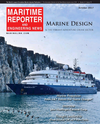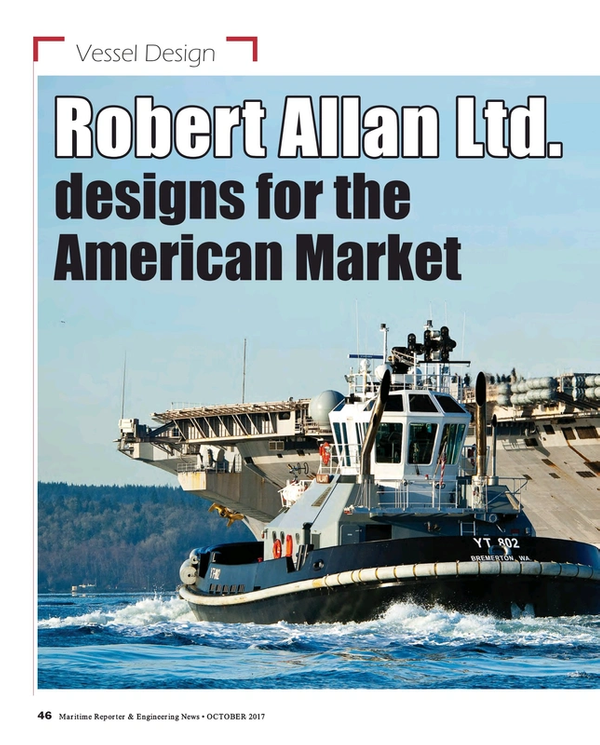
Robert Allan Ltd. Designs for the American Market
By Roland H. Webb
Being based just across the open border between Canada and America since 1930, Robert Allan Ltd. has developed a deep understanding of the American market and just how our ship designs can be tailored to suit our neighbors’ requirements.
America is unique in many ways. The current designs of American towing vessels are largely the result of domestically focused requirements not encountered elsewhere. As a result, Robert Allan Ltd. has had to learn to treat America as unique and not to assume means and methods used elsewhere will suit the U.S. market.
A simple example is the use of the U.S. Standard system of measurements as opposed to the metric system in use elsewhere. Our designs are metric with frame numbers starting aft and running forward; however, we can and do willingly provide designs in U.S. standard dimensions and increments of frame spacing, using angles instead of bulbs etc., and have even figured out how to reorganize frame numbers running from bow to stern.
All joking aside, it is fair to say the U.S. market is very competitive and demanding. Based in Vancouver, BC, only a few short hours away from Seattle by car, it is not surprising that Robert Allan Ltd. began selling fishing vessel designs to U.S. clients as early as the 1960s, and tugs in 1970 and continues to do so. Early customers included Dunlop Towing and Puget Sound Freight Lines of Washington State. They were followed by Hawaiian Tug & Barge and Shaver Transportation who both acquired versions of the Cates 2,400 hp ASD ship handling tugs initially developed for use in Vancouver harbor. We continue to work hard to understand the market and will never assume we are entitled to ongoing participation.
Some of our U.S. clients include G & H Towing, Signet Maritime, Wilmington Tug, Foss Maritime, Harvey Gulf and the U.S. Navy, to name a few. Bay-Houston Towing Co. and Suderman & Young Towing Company have recently ordered total eight more improved Z-Techs for use in Gulf Coast ports, increasing their fleet to 24 such vessels. G & H Towing will operate these vessels. This new design incorporates sponsons for increased stability when performing escort towing duties, with the additional benefit of reduced motion in seaway.
Signet Maritime has built and/or operates 10 tugs of Robert Allan Ltd. design that work in ports along the U.S Gulf Coast. The most recent of these was the RApport 2400 Class vessel Gladys B built by Signet (at the Signet shipyard in Pascagoula) for E.N. Bisso & Son. Inc. Other recent deliveries include the RAmparts 3200 Class design vessels Signet Arcturus and Signet Polaris built for Signet by Patti Marine Enterprises in 2014, and the Signet Magic (also built at the Signet shipyard in Pascagoula)
The U.S. Navy has six Z-Tech tugs operating with the Pacific Fleet from bases in Japan and Washington State. These vessels were built by J. Martinac at Tacoma, Washington from 2007-2012. A tender for six more tugs for this client is underway as this article goes to print but no final selection of the design or builder has been announced.
Harvey Gulf now operates the largest version of the RAmpage family, our “Swiss Army Knife” AHTS design. This unique vessel, the Harvey Stone, was built by Eastern Shipbuilding and delivered in 2016. With a bollard pull of 117 short tons from a Tier 4 diesel electric hybrid plant in a compact yet efficient hull, 212 ft. (65 m) in overall length, this unique multipurpose vessel performs a full range of services for the Shell Stone offshore field.
On the West Coast, Diversified Marine Industries of Portland have been building Robert Allan Ltd. designs since the turn of the century. Two new “enhanced” RAmparts 2400 class vessels, the Michelle Sloan and Lela Franco were completed by them for Harley Marine Services in 2015 making 10 in total. This year two more vessels of the same class, the Dr. Hank Kaplan and Rich Padden will also join the Harley fleet.
Earlier this year, the first U.S. built Rotor Tug, ART Trident, was delivered to Seabulk Towing of Fort Lauderdale, Fla., by Master Boat Builders of Bayou La Batre, Ala. This new and unique Robert Allan Ltd. design, which was initially conceived and developed by Rotortug B.V. of the Netherlands, will truly raise the bar for ship-handling operations in U.S. waters. Three of these vessels will be delivered to Seabulk from the Master Boat Builder facility, with the third vessel in this series (the Trinity) scheduled to be delivered at the end of this year.
While we are probably best known to American owners for our towing vessel designs, we are also active in the fireboat market with 10 vessels of eight very unique designs having been built and delivered to major U.S. cities since 2001. Philadelphia, Boston, Baltimore, Portland, Maine, Chicago, Los Angeles, Long Beach and New York all have new fireboats designed by Robert Allan Ltd. protecting their waterfronts.
On the horizon, amongst the known designs, is a new vessel for the Saint Lawrence Seaway Development Corporation which will be the first true icebreaking towing vessel built in America for generations. To be based at Massena, N.Y, this new vessel is developed from the recently completed TundRA 3600 class vessels Ocean Tundra and Ocean Taiga, built in Quebec for service in Canadian waters. The solicitation to select the builder is underway and award is expected later this year.
On the broader horizon is the new world of the so-called neo-panamax container ship that the new Panama Canal has made practical and numerous. These highly efficient behemoths are already calling at U.S. ports on both coasts, and coupled with the simultaneous buildup of oil and LNG exports, they will create a demand for even more powerful and reliable tugs. The 70 to 80 ton bollard pull datum of today will increase quickly as more capability is required by Port Authorities and pilots. Insurance companies, who underwrite the risk of such larger vessels navigating in restricted waterways, will support this need and ship owners will see the prudence of requiring proportionally capable tugs to be available on a 24/7 basis.
Typical examples of what the future already holds are the recently completed Robert Allan Ltd. designed RAstar 85 Class escort tugs and the ART 85-32W Class Rotortug design now under construction, all for service at Port Headland, Australia’s busiest iron export facility. See:
- http://ral.ca/2017/04/11/rastar-85-for-western-australia/ and
- http://ral.ca/2017/05/31/art-85-32w-fortescue-metals/
Progress won’t stop there; even more powerful and capable designs are being developed to ensure the towing vessels of tomorrow will match the demands of their time. Standby!
The Author
Roland H. Webb os Senior Vice President, Robert Allan Ltd.
(As published in the October 2017 edition of Maritime Reporter & Engineering News)
Read Robert Allan Ltd. Designs for the American Market in Pdf, Flash or Html5 edition of October 2017 Maritime Reporter
Other stories from October 2017 issue
Content
- Supporting Silent Ships page: 14
- Cyber Shoal Waters page: 18
- US Shipbuilding: The Road Ahead page: 22
- Keller Shifts Gears page: 24
- MAN Introduces the 'Game Changer' page: 26
- Voices: Bjarne Foldager, MAN Diesel & Turbo page: 30
- Voices: John Haeflinger, Carnival Corp. page: 35
- Designer-built Adventure Cruise page: 40
- Robert Allan Ltd. Designs for the American Market page: 46
- Foreship: A Guiding Design Light amid a Quagmire of Regulations page: 50
- Hans Beele's Mission to Build Sealing Valley page: 58
- Ship of the Month: October 2017 page: 62


